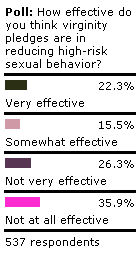Poll: Virginity Pledges [November 2007]
How effective do you think virginity pledges are in reducing high-risk sexual behavior? Here is what the research says:
1. Although young people who sign virginity pledges may delay the initiation of sexual activity and have fewer sexual partners, they are less likely to use condoms when they do have sex.[1]
2. Those who make virginity pledges (promising to abstain from vaginal intercourse) are more likely than those who do not sign such pledges to engage in risky sexual behavior, such as unprotected oral and anal sex.[1]
3. Youth who take virginity pledges have the same rate of sexually transmitted infections as those who do not take virginity pledges.[1]
4. Youth who make private pledges (i.e., promises to themselves) to wait until they are older to have sex are less likely to engage in sexual intercourse and oral sex than those who do not. Making formal pledges—such as public virginity pledges that are part of some abstinence-only-until-marriage curricula—does not appear to have an effect on sexual behavior.[2]

Poll ended November 2007. |
What these data tell us is that neither virginity pledges nor abstinence-only-until-marriage education are effective in protecting young people from sexually transmitted infections, including HIV. These data are bolstered by a recent, federally supported study that evaluated four of the leading abstinence-only-until-marriage programs in the U.S. and found no evidence of efficacy in changing teens’ sexual behavior.[3]
Although abstinence can be an effective prevention option for youth, the reality is that 46 percent of teens have sex before they finish high school.[4] Curricula that incorporate virginity pledges often demonize sexuality and teach youth to feel guilty about their sexual impulses, which can lead to unhealthy views of sexual relationships.[5] Additionally, because sexual behavior is almost invariably described as being acceptable only in the context of a heterosexual marriage, gay, lesbian, bisexual, and transgender (GLBT) youth, who are not legally allowed to marry persons of the same gender, are stigmatized and marginalized. Given that GLBT youth are at particularly high risk for HIV and other sexually transmitted infections, this means that they are denied prevention information that could save their lives.
Comprehensive sexuality education can promote abstinence as an option, but it can also teach youth how to protect themselves when they are ready to become sexually active. For all youth, education is the most effective form of prevention.
Thank you for your answer and for your interest in this issue. We hope this information has been helpful. Please check back for next month’s polling question.
REFERENCES
[1] Bearman and Bruckner, 2005 After the Promise: The STD Consequences of Adolescent Virginity Pledges. J Adolesc Health 2005; 36 (4): 271-8.
[2] Bersamin MM, Walker S, Waiters ED, Fisher DA, Grube JW. Promising to Wait: Virginity Pledges and Adolescent Sexual Behavior. J Adolesc Health 2005; 36 (5): 428-36
[3] Mathematica Policy Research. Impacts of Four Title V, Section 510 Abstinence Education Programs: Final Report, April 2007. Washington, D.C.: Mathematica Policy Research, Inc. Available at: http://www.mathematica-mpr.com/publications/PDFs/impactabstinence.pdf
[4] Abma JC et al., Teenagers in the United States: Sexual Activity, Contraceptive Use, and Childbearing, 2002, Vital and Health Statistics, 2004, Series 23, No. 24. In Guttmacher Institute. In Brief: Facts on American Teens’ Sexual and Reproductive Health. September 2006. Available at: http://www.guttmacher.org/pubs/fb_ATSRH.htm
[5] Santelli J, Ott MA, Lyon, M, Rogers J, Summers D, Schleifer R. Abstinence and Abstinence-Only Education: A Review of U.S. Policies and Programs. J Adolesc Health 2006; 38: 72-81.